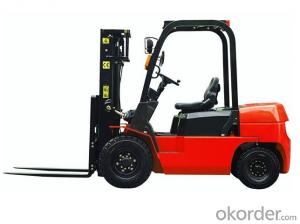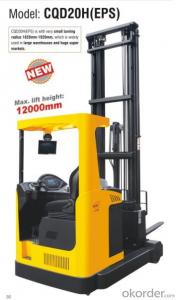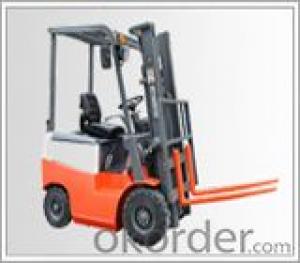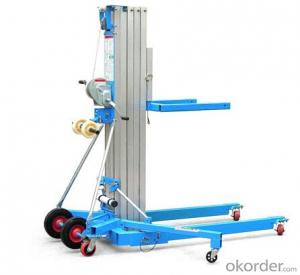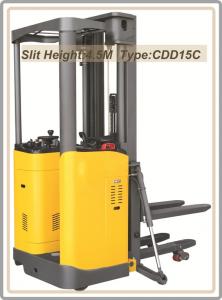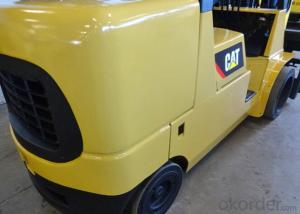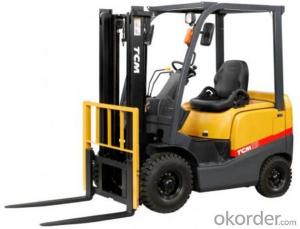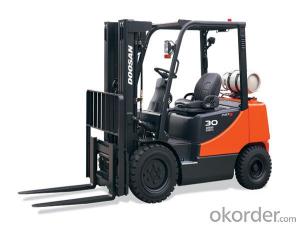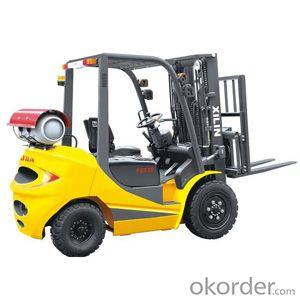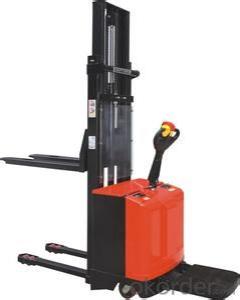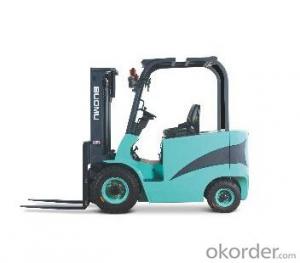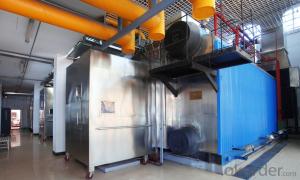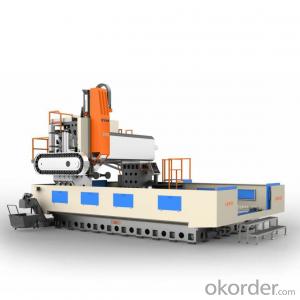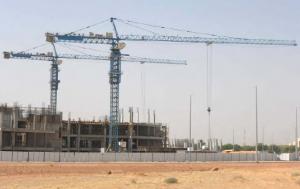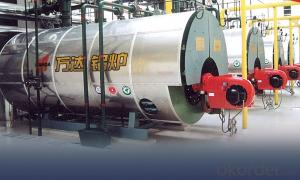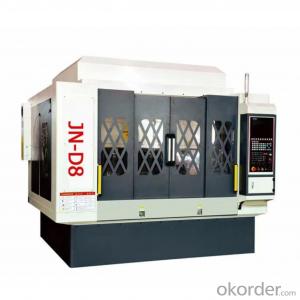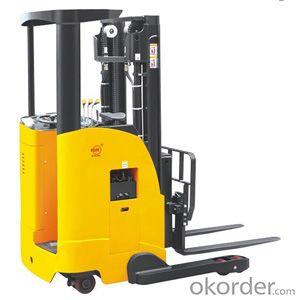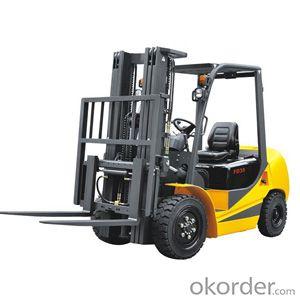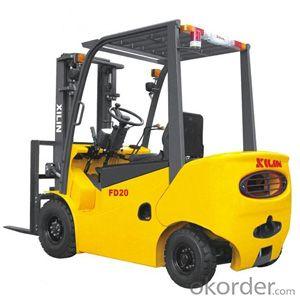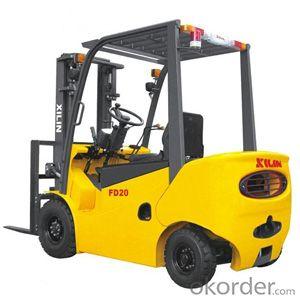5 Tons Diesel Powered Forklift product CPCD50F
- Loading Port:
- Shanghai
- Payment Terms:
- TT or LC
- Min Order Qty:
- 1 unit
- Supply Capability:
- 1 unit/month
OKorder Service Pledge
OKorder Financial Service
You Might Also Like
Forklift Description:
A forklift truck (also called a lift truck, a fork truck, or a forklift) is a powered industrial truck used to lift and move materials short distances. The forklift was developed in the early 20th century by various companies including the transmission manufacturing company Clark and the hoist company Yale & Towne Manufacturing. Following World War II the use and development of the forklift truck has greatly expanded worldwide. Forklifts have become an indispensable piece of equipment in manufacturing and warehousing operations. In 2013 alone the top 20 manufacturers worldwide posted sales of $30.4 billion with 944,405 machines sold.;and the U.S. forklift market was nearly $33 billion.
General operations
Forklift cab with control layout.
Forklifts are rated for loads at a specified maximum weight and a specified forward center of gravity. This information is located on a nameplate provided by the manufacturer, and loads must not exceed these specifications. In many jurisdictions it is illegal to remove or tamper with the nameplate without the permission of the forklift manufacturer.
An important aspect of forklift operation is that most have rear-wheel steering. While this increases maneuverability in tight cornering situations, it differs from a driver’s traditional experience with other wheeled vehicles. While steering, as there is no caster action, it is unnecessary to apply steering force to maintain a constant rate of turn.
Another critical characteristic of the forklift is its instability. The forklift and load must be considered a unit with a continually varying center of gravity with every movement of the load. A forklift must never negotiate a turn at speed with a raised load, where centrifugal and gravitational forces may combine to cause a disastrous tip-over accident. The forklift are designed with a load limit for the forks which is decreased with fork elevation and undercutting of the load (i.e., when a load does not butt against the fork "L"). A loading plate for loading reference is usually located on the forklift. A forklift should not be used as a personnel lift without the fitting of specific safety equipment, such as a "cherry picker" or "cage".
Forklifts are a critical element of warehouses and distribution centers. It’s imperative that these structures be designed to accommodate their efficient and safe movement. In the case of Drive-In/Drive-Thru Racking, a forklift needs to travel inside a storage bay that is multiple pallet positions deep to place or retrieve a pallet. Often, forklift drivers are guided into the bay through guide rails on the floor and the pallet is placed on cantilevered arms or rails. These maneuvers require well-trained operators. Since every pallet requires the truck to enter the storage structure, damage is more common than with other types of storage. In designing a drive-in system, dimensions of the fork truck, including overall width and mast width, must be carefully considered.
Forklift control and capabilities
Forklift hydraulics are controlled either with levers directly manipulating the hydraulic valves, or by electrically controlled actuators, using smaller "finger" levers for control. The latter allows forklift designers more freedom in ergonomical design.
Hydraulic elevator for tractors
Forklift trucks are available in many variations and load capacities. In a typical warehouse setting most forklifts have load capacities between one and five tons. Larger machines, up to 50 tons lift capacity, are used for lifting heavier loads, including loaded shipping containers.
In addition to a control to raise and lower the forks (also known as blades or tines), the operator can tilt the mast to compensate for a load's tendency to angle the blades toward the ground and risk slipping off the forks. Tilt also provides a limited ability to operate on non-level ground. Skilled forklift operators annually compete in obstacle and timed challenges at regional forklift rodeos.
Design types
A truck mounted forklift.
The following is a list, in no particular order, of the more common lift truck types:
Hand pallet truck - no on-board power system of any kind; the operator's muscle power is used to jack-up and move loads.
Walkie low lift truck- powered pallet truck, usually electrically powered
Rider low lift truck - usually electrically powered
Towing tractor - may be internal combustion engine or electrically powered
Walkie stacker - usually electrically powered
Rider stacker - usually electrically powered, e.g., A Ergo
Reach truck - variant on a Rider Stacker forklift, designed for small aisles, usually Electrically Powered, named because the forks can extend to reach the load. There are two variants, moving carriage, which are common in North America, and moving mast which are common in the rest of the world, and generally regarded as safer.
Forklift Specification:
Model | CPCD50F | |
Load capacity kg | 5000 | |
Load center mm | 500 | |
Power type | Diesel | |
Max.lifting speeds(with load)mm/s | 375 | |
Max.Driving speeds(with without load)km/h | 20/24 | |
Max.Towing speeds(with/without load)kN | 31/18 | |
Gradeability(with/without load)% | 15/20 | |
H1 Lifting height mm | 3000 | |
Free lift mm | 150 | |
Tilting angles(forward-backward) 。 | 6/12 | |
Min. turning radius mm | 3000 | |
Min. right angle aisle width mm | 2750 | |
Min. under-clearance mm | 170 | |
Dimensions | A Overall length (inincluding fork) mm | 4350 |
B Overall width mm | 1400 | |
H Overall height(mast lowered) mm | 2330 | |
H2 Overall height(mast extend) mm | 4265 | |
H3 Overall height to overhead guard mm | 2330 | |
A1 Fork overhang mm | 565 | |
A2 Wheel base mm | 2150 | |
Tread | B1 Front tread mm | 300-15 |
B2 Rear tread mm | 7.00-12 | |
Tyre | Front tyre | 1180 |
Rear tyre | 1190 | |
Total weight kg | 6800 | |
B3 Fork width mm | 150 | |
H4 Fork thickness mm | 55 | |
Backrest height mm | 1275 | |
A3 Fork length mm | 1070(1220) | |
Engine | Engine model | LR4A3-G |
Rate power KW | 59 | |
Rotate Speed At Rate Power rpm | 2400 | |
Max.torque Nm | 275 | |
Rotate speed at max torque rpm | 1680 | |
Type of power shift | Hydraulic | |
Forklift Images:
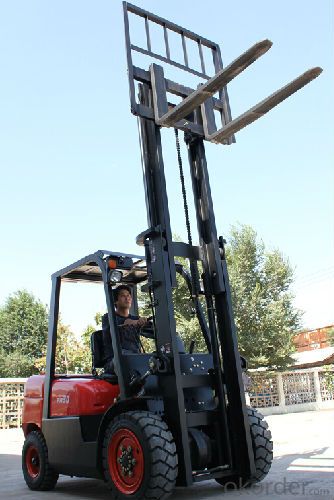
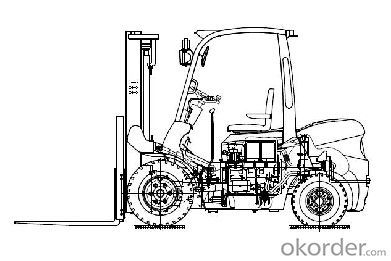
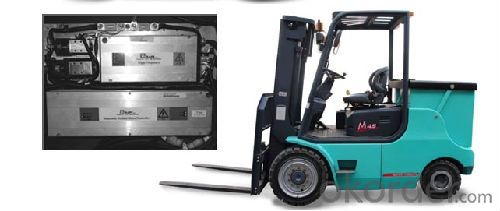
FAQ of forklift:
Q: What’s the function of forklift?
A: A forklift truck (also called a lift truck, a fork truck, or a forklift) is a powered industrial truck used to lift and move materials short distances. The forklift was developed in the early 20th century by various companies including the transmission manufacturing company Clark and the hoist company Yale & Towne Manufacturing. Following World War II the use and development of the forklift truck has greatly expanded worldwide. Forklifts have become an indispensable piece of equipment in manufacturing and warehousing operations.
Q: What’s the general operations of forklift:
A: Forklift cab with control layout.
Forklifts are rated for loads at a specified maximum weight and a specified forward center of gravity. This information is located on a nameplate provided by the manufacturer, and loads must not exceed these specifications. In many jurisdictions it is illegal to remove or tamper with the nameplate without the permission of the forklift manufacturer.
Q: What are the Forklift safety Standards?
A: 1, Forklift safety is subject to a variety of standards world wide. The most important standard is the ANSI B56—of which stewardship has now been passed from the American National Standards Institute (ANSI) to the Industrial Truck Standards Development Foundation after multi-year negotiations. ITSDF is a non-profit organization whose only purpose is the promulgation and modernization of the B56 standard.
2, Other forklift safety standards have been implemented in the United States by the Occupational Safety and Health Administration (OSHA) and in the United Kingdom by the Health and Safety Executive.
3, Driver safety: In many countries forklift truck operators must be trained and certified to operate forklift trucks. Certification may be required for each individual class of lift that an operator would use.
- Q:How many kilograms are on the top of the forklift truck
- Second, a forklift is typically designed to prevent a high-flying object from falling and hurling a protective device. So don't put too much weight on the top shelf. Finally, good luck to you!
- Q:What is a forklift for?
- One, model choice 1, category 1 Forklift can be divided into three categories: internal combustion forklift, electric forklift and storage forklift. (1) internal combustion forklift The internal combustion forklift is divided into regular internal combustion forklift, heavy lift truck, container forklift truck and side forklift truck. Normal internal combustion forklift Generally use diesel, gasoline, liquefied petroleum gas or natural gas engine as power, load capacity of 1.2 ~ 8.0 tons, homework channel width is generally 3.5 ~ 3.5 meters, emissions and noise into consideration, usually used in outdoor, workshops or other places with special requirements for emissions and noise did not. Due to the convenience of fuel replenishment, long time continuous work can be achieved, and can be suitable for work in bad environment (such as rain).
- Q:About the safety of driving forklifts
- Keep in mind that the goods are overloaded and don't try, or you will be fired by your boss. Insert the insertion of the teeth, the distance between the teeth, the higher the load, the lower center of the drive.Safety of the forklift should be remembered..
- Q:The repair process of forklift inspection
- Before doing any maintenance work, you must complete the process, including placing the forklift in the plane and making sure it doesn't suddenly move. Completely put down the fork; Close the forklift and remove the key; Finally, press the emergency brake button.
- Q:How many ways to push the forklift truck?
- The container forklift truck is powered by diesel engine, carrying capacity of 8.0 to 45.0 tons, which is generally divided into empty box, heavy box and container head crane. Apply to container handling such as container yard or port terminal. The lateral forklift truck is powered by a diesel engine with a capacity of 3.0-6.0 tons. In the case of not turning, the ability to take the goods directly from the side and fork, therefore, the main purpose is to take the long line of goods such as wood bar, steel bar and so on. Electric forklifts are powered by motors and batteries for energy. The load capacity is 1.0-8.0 ton, and the width of the job channel is usually 3.5-5.0 meters. There is no pollution or noise
- Q:The forklift is limited in the factory area
- 5KM/H, the water on a forklift, people go beyond 5KM in an hour. A bit of efficiency is gone. In the case of safety, no matter, the maximum of 20KM/H, the maximum of 15KM/H. This is the top speed of a small tonklift truck.
- Q:How do you change the oil of the forklift truck, without a slot and a jack, so you can change it on the ground? Do you know a teacher?
- You can do it with a little bit of energy and you can see it on the low side of the low shell and the oil screw
- Q:The depreciation period and the rate of depreciation of engineering machinery such as forklift truck
- The enterprise income tax law of the People's Republic of China regulations on the implementation of article 60: unless it is otherwise prescribed by the competent financial and tax departments under the state council, the computation of depreciation of fixed assets fixed number of year of the lowest is as follows: (1) houses, buildings, for 20 years; (2) aircraft, trains, ships, machinery, machinery and other production facilities for 10 years; (3) the equipment, tools, furniture, etc., which are related to the production and operation activities, shall be five years; (4) transport vehicles, other than aircraft, trains and ships, for four years; (5) electronic equipment, for 3 years.
- Q:Is it dangerous to drive a forklift?
- Of course there will be, the forklift truck is also a big guy, hey hey. But the operator's technology is good, and there is nothing wrong with concentration
- Q:What do you mean by the center spacing of the load on an electric forklift?
- For a balanced electric forklift or a battery-powered stacking, a little extra weight or the center of mass of the cargo is not a problem in front of the load center. I said a little bit. But for stacker, because be stacker itself weight is light, so if you exceed and load or the goods promotion center migration, is likely to cause instability and collapse! So you need extra attention when you're using a stack. In particular, a semi-electric truck and a manual hydraulic stack. Because the body itself weighs less than two hundred kilograms, it would be too dangerous to raise a ton or two tons of goods, plus a central shift.
1. Manufacturer Overview |
|
|---|---|
| Location | |
| Year Established | |
| Annual Output Value | |
| Main Markets | |
| Company Certifications | |
2. Manufacturer Certificates |
|
|---|---|
| a) Certification Name | |
| Range | |
| Reference | |
| Validity Period | |
3. Manufacturer Capability |
|
|---|---|
| a)Trade Capacity | |
| Nearest Port | |
| Export Percentage | |
| No.of Employees in Trade Department | |
| Language Spoken: | |
| b)Factory Information | |
| Factory Size: | |
| No. of Production Lines | |
| Contract Manufacturing | |
| Product Price Range | |
Send your message to us
5 Tons Diesel Powered Forklift product CPCD50F
- Loading Port:
- Shanghai
- Payment Terms:
- TT or LC
- Min Order Qty:
- 1 unit
- Supply Capability:
- 1 unit/month
OKorder Service Pledge
OKorder Financial Service
Similar products
New products
Hot products
Related keywords
